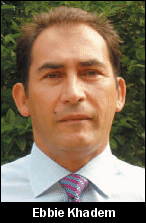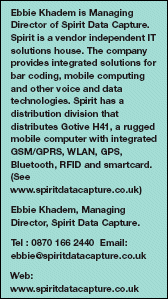 End-users requirements regarding data capture are constantly evolving. This is driven by rapid progress in technology. End-users can see a great opportunity for automating and improving the means of capturing data. The result being increasing levels of accuracy and efficiency within their organisation.
End-users requirements regarding data capture are constantly evolving. This is driven by rapid progress in technology. End-users can see a great opportunity for automating and improving the means of capturing data. The result being increasing levels of accuracy and efficiency within their organisation.
Recent years have seen an increasing end-user awareness of RF, GSM and GPRS technology. This has driven user demand for auto ID products (and specifically portable devices) to integrate these technologies. As a result, auto ID products are becoming more and more downstream products, affecting all parts of the business.
The auto ID market is changing rapidly. This market will follow most of the trends already seen in the general IT market. For example, many auto ID products will become commodities in the eyes of the buyer. We have seen this process happening in the IT market, where PCs are packaged up and sold through high street retailers.
Although auto ID products are moving in the same direction, they will remain a business-tobusiness
product area. The expectations are that distribution channels will increasingly align themselves to a two-step distribution model.
The two-step distribution process delivers a fast response to enduser needs and requirements. The route from the manufacturer will be through a two-step distributor who will stock the product for fast deliveries through to the value-added reseller (VAR). In turn, the VAR will add more value to the package, i.e., software, installation, configuration and/or integration with other systems.
As a result, the end-user will benefit from a more complete solution. It would be extremely difficult for the manufacturer, the two-step distributor or the VAR to provide this total solution without co-operation from the other two.
This approach will have numerous advantages for customers. For example, better stock availability, a variety of purchasing options and competitive pricing. As far as the manufacturer is concerned, there will be a huge amount of marketing activity carried out by the intermediary, supported by the manufacturer.
This two-step system will have to support the existing auto ID channel community. It will also mean the expansion of he market, by bringing in other IT resellers to add additional value to the products.
The current two-step distributors will have to move with the rapid changes in the market and demonstrate the added value they bring to the market. At a European level they must have local expertise and ensure that product offerings are geared up for those specific markets.
The VARs will have to focus on providing the final solution to the end-user. The better the solution, the more competitive the VAR will be.
The manufacturers focus will have to become more streamlined. It will have to focus on what businesses need-rather than what they can provide. The packaging of the products will also have to change in order to satisfy the everincreasing requirement for simplicity and out-of-box working products. This is quite a challenge for an industry that has prided itself on complexity and the mysteries of bar coding! The key will  be simplicity.
be simplicity.
As the demand for information and the amount of data increases, auto-ID technology will have to move with the times. Linear and 2D bar coding have been at the forefront of this change. The technology providers have tried to deliver this by using conventional methods of data capture, for example, laser and CCD scanning.
To provide better means of collecting data, the trend points towards RFID and imaging. We are starting to see the wider adoption of RFID. However until the cost of the tags come down, then it will never be a credible challenger to bar coding.
Imaging provides the capability to scan and decode linear and 2D codes, as well as capturing visual information such is signatures. However, the cost of the technology will also need to fall for this solution to be widely accepted.

Add a Comment
No messages on this article yet